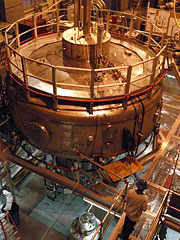Novel fusion device mimics the planets
“Satellites that went past Jupiter in the 1980s discovered a relatively high pressure plasma surrounding Jupiter,” said Kesner. Holding the plasma in place is the planet’s strong magnetic field. The Levitated Dipole Experiment, or LDX, is intended to recreate Jupiter’s magnetic field in an Earth-bound lab at MIT.
The LDX concept calls for floating a superconducting ring the size and shape of a freight-truck tire inside a vacuum chamber—a metal canister 4 meters high and 5 meters wide. To start out, the superconducting ring is cooled to a few degrees above absolute zero and has an electrical current induced inside it. It is then mechanically lifted and held in place by an overhead magnet that counterbalances the force of gravity. As the ring floats, the electrical current inside it flows without resistance, creating a magnetic field that circles vertically around the ring.
The simple dipole field resembles the field around a magnetic planet, which loops from one pole to the other. But with no planet at the center and no supports to interfere, the field lines around the floating ring form continuous vertical circles. Plasma particles—formed by microwaving injected deuterium—are captured and carried round and round the outside of the coil, confined by the magnetic field lines. According to theory, this type of field should support fusion using just deuterium, a form of hydrogen abundant in seawater. Other proposed designs require deuterium plus tritium, a radioactive element that must be made in a “blanket” that surrounds the reactor.


